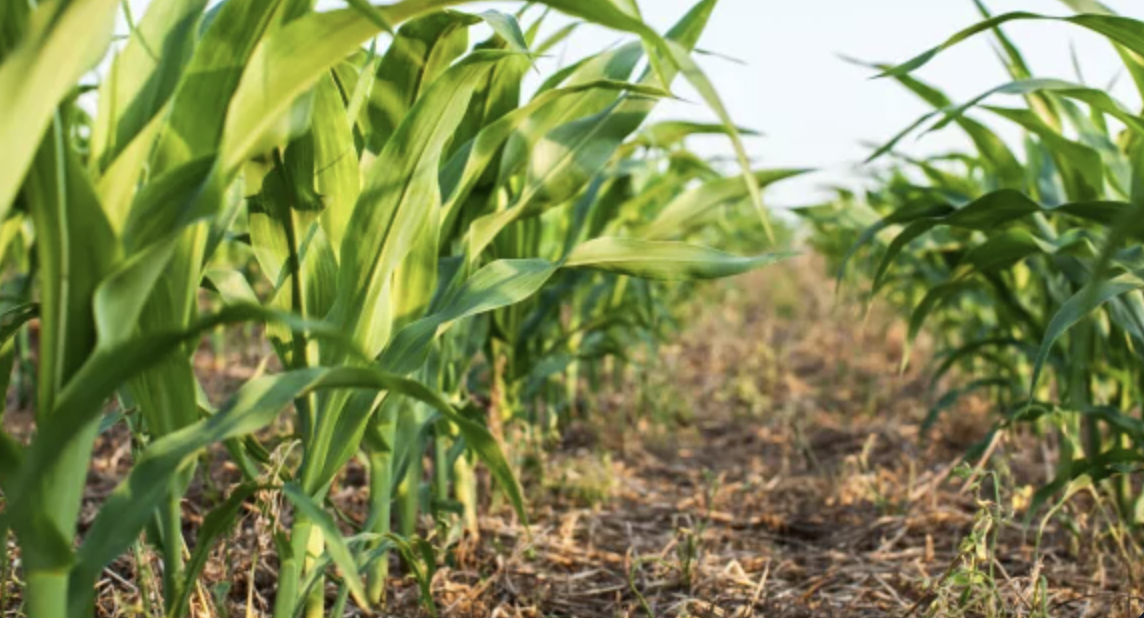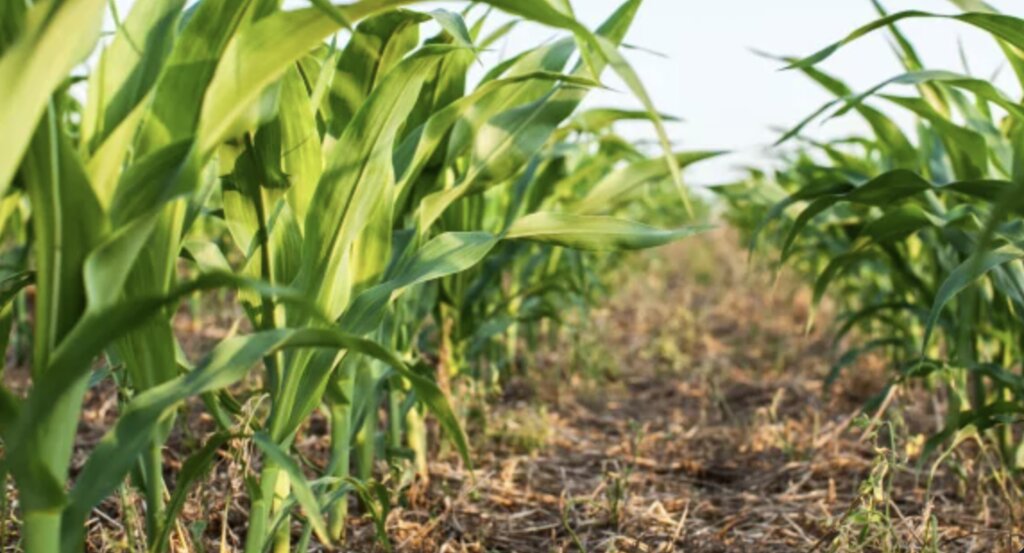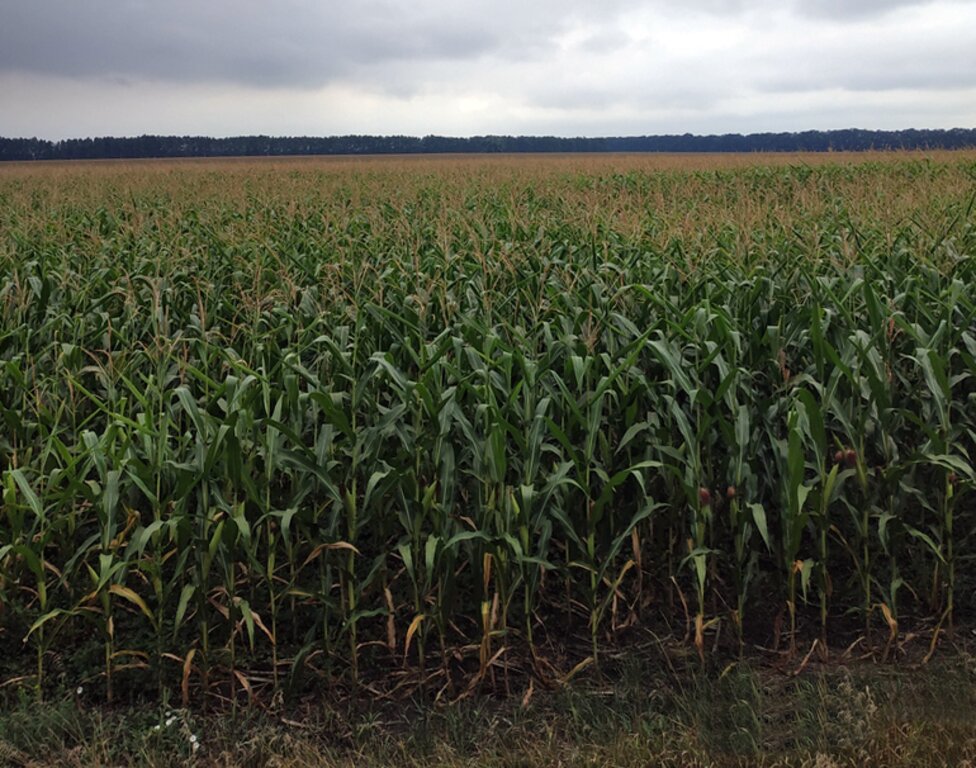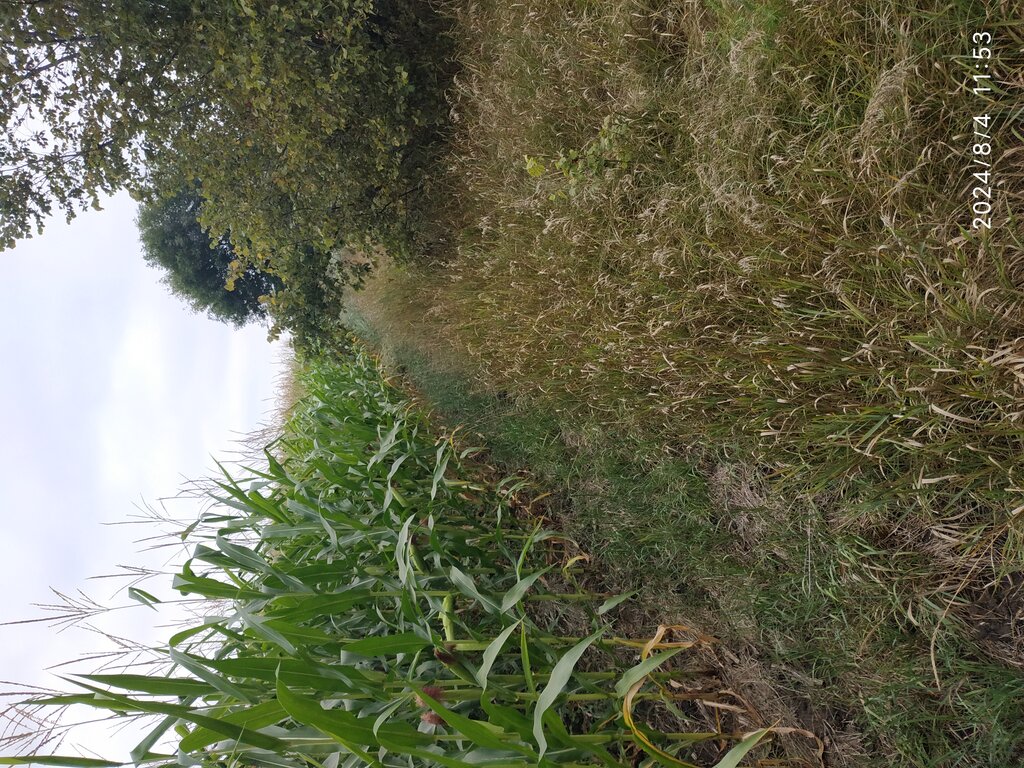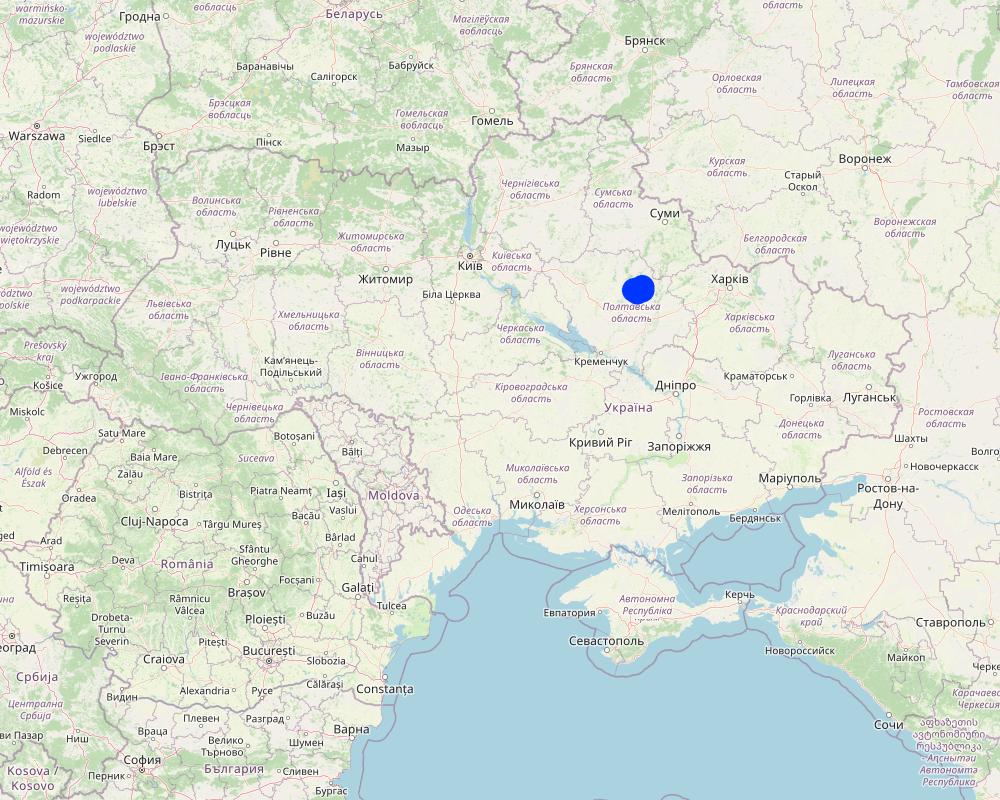Organic Agriculture with Reduced Tillage [Ucrania]
- Creación:
- Actualización:
- Compilador: Natalia Prozorova
- Editor: –
- Revisores: William Critchley, Rima Mekdaschi Studer
Organic Agriculture
technologies_7440 - Ucrania
Visualizar secciones
Expandir todo Colapsar todos1. Información general
1.2 Detalles de contacto de las personas de referencia e instituciones involucradas en la evaluación y la documentación de la Tecnología
Persona(s) de referencia clave
Especialista MST:
Prozorova Natalia
National Scientific Center «Institute for SoilScience and Agrochemistry Research, named after O.N. Sokolovsky»
Ucrania
Nombre del proyecto que financió la documentación/ evaluación de la Tecnología (si fuera relevante)
Land Use Based Mitigation for Resilient Climate Pathways (LANDMARC)Nombre de la(s) institución(es) que facilitaron la documentación/ evaluación de la Tecnología (si fuera relevante)
Delft University of Technology (TU Delft)1.3 Condiciones referidas al uso de datos documentados mediante WOCAT
El compilador y la/s persona(s) de referencia claves aceptan las condiciones acerca del uso de los datos documentados mediante WOCAT:
Sí
1.4 Declaración de la sostenibilidad de la Tecnología descrita
¿La Tecnología aquí descrita resulta problemática en relación a la degradación de la tierra, de tal forma que no puede considerársela una tecnología sostenible para el manejo de la tierra?
No
2. Descripción de la Tecnología MST
2.1 Breve descripción de la Tecnología
Definición de la Tecnología:
This organic agriculture technology combines reduced tillage with organic farming practices to enhance soil health, increase carbon sequestration, and maintain sustainable agricultural productivity.
2.2 Descripción detallada de la Tecnología
Descripción:
This example of organic agriculture is applied primarily in the central Poltava region of Ukraine, which is characterized by undulating plains within the Poltava Plateau. The region’s fertile chernozem soils provide an ideal environment for sustainable farming practices. These soils are predominantly deep, medium-humus, medium-loam chernozems, known for their agronomically favourable physical and chemical properties, including high organic carbon content (around 3% in the upper layer) and excellent water retention capacity. The natural fertility of these soils, combined with their relatively high nitrogen and exchangeable potassium content, underpins their suitability for organic farming.
Organic agriculture in this context combines two land management technologies (LMTs): reduced tillage and organic farming. Reduced tillage minimizes soil disturbance, which preserves soil structure and reduces erosion, while organic farming eliminates synthetic inputs and relies on crop rotations, organic fertilizers, and biological pest control to maintain soil health and ecosystem balance. The purpose of these practices is to enhance soil carbon sequestration, mitigate climate change impacts, and support sustainable agricultural productivity.
Farming is certified as a producer of organic plant products in accordance with the standards equivalent to Council Resolutions (EU) 834/2007 and 889/2008.
Under this system, shallow tillage is carried out to a depth of 4–6 cm, which helps preserve the natural structure and capillarity of the soil. It employs Horsch cultivators of the "Agrosoyuz," "Scorpion," and "Quant" models. The enterprise also extensively uses disc harrows from the French manufacturer Grégoire Besson, such as the DXRV and DXRV-HD models, which are employed for green manure incorporation. These tools operate at a precisely determined depth, regardless of the micro-relief of the field. Thus, PE "Agroecology" does not use ploughs for inversion tillage but instead prioritizes shallow tillage with cultivators and disc harrows.
The main crops grown include winter wheat, soy, corn, sunflower, and perennial herbs such as sainfoin. The combination of these crops supports soil fertility and biodiversity while maintaining agricultural productivity. Land Mitigation Technology (LMT) refers to practices and technologies designed to reduce or offset the environmental impact of land use activities. It includes strategies for restoring degraded ecosystems, preventing soil erosion, conserving biodiversity, and managing resources sustainably. LMT is often applied in agriculture, construction, and land development to balance development needs with environmental protection.
Key activities to establish and maintain the technology include transitioning from conventional to organic farming practices, adapting tillage methods to reduced-intensity operations, and maintaining organic soil fertility through natural inputs. These activities require significant initial effort and investment, including soil testing for nutrient content and organic carbon stocks, stakeholder engagement for field planning, and long-term monitoring of soil health indicators. The establishment process also involves collaboration with scientific institutions, such as ISSAR and Bioclear Earth, to ensure effective implementation and validation of the technology.
The primary benefits of this technology include improved soil structure, increased biodiversity, reduced greenhouse gas emissions, and enhanced carbon sequestration. The technology has demonstrated the potential to sequester up to 0.4 t C ha⁻¹ yr⁻¹, with minimal yield trade-offs. Additionally, the resilience of the chernozem soils supports similar crop yields in both organic and conventional systems, thanks to their natural fertility and lower input rates in conventional agriculture. Farmers particularly value the long-term sustainability and ecological benefits of organic farming.
Land users face challenges with this technology. Transitioning to organic farming can result in temporary yield reductions, requiring adaptation in farm management practices. Furthermore, reduced tillage demands specific equipment and techniques, which may present a financial barrier for some farmers. The implementation of organic farming also requires significant effort in pest and weed management due to the absence of chemical inputs.
Overall, this form of organic agriculture represents a promising approach to sustainable farming in Ukraine, particularly in the fertile Chernozem region. Its ability to enhance carbon sequestration while maintaining comparable yields to conventional systems highlights its potential to contribute to climate mitigation and soil restoration goals. Further research and field validation are needed to refine the understanding of its impacts and optimize its implementation.
2.3 Fotografías de la Tecnología
Comentarios generales sobre las fotos:
The photos provide a detailed view of the agricultural practices in the field, highlighting the healthy state of the maize crops in central Ukraine. These images capture the natural environment where organic farming techniques are being applied, showcasing the crops' growth, the quality of the soil, and the overall ecological balance. The close-up shots emphasize the care taken to maintain soil health and biodiversity, aligning with the principles of organic farming. The visuals also illustrate the sustainable land management practices that promote environmental stewardship and high agricultural yields.
2.5 País/ región/ lugares donde la Tecnología fue aplicada y que se hallan comprendidos por esta evaluación
País:
Ucrania
Región/ Estado/ Provincia:
Poltava region, Shishaky area
Especifique más el lugar :
Poltava region on the left bank of the river Psyol, in 20 km from urban-type settlement Shishaky and in 80 km to the regional center Poltava
Especifique la difusión de la Tecnología:
- distribuida parejamente sobre un área
Si se desconoce el área precisa, indique el área aproximada cubierta:
- 1,000-10,000 km2
¿El/los sitio(s) de la Tecnología se ubica(n) en un área de protección permanente?
No
Map
×2.6 Fecha de la implementación
Si no se conoce el año preciso, indique la fecha aproximada:
- 10-50 años atrás
2.7 Introducción de la Tecnología
Especifique cómo se introdujo la Tecnología:
- mediante la innovación de usuarios de tierras
3. Clasificación de la Tecnología MST
3.1 Propósito(s) principal(es) de la Tecnología MST
- reducir, prevenir, restaurar la degradación de la tierra
- adaptarse al cambio climático/ extremos climáticos y sus impactos
- mitigar cambio climático y sus impactos
- chernozem productivity assessment between conventional and traditional agriculture
3.2 Tipo(s) actuales de uso de la tierra donde se aplica la Tecnología
Mezcla de tipos de uso de tierras dentro de la misma unidad de tierras: :
No

Tierras cultivadas
- Cosecha anual
- Perennial herbs
Cosechas anuales - Especifique cultivos:
- cereals - buckwheat
- cereales - trigo (invierno)
Sistema anual de cultivo:
Trigo o rotación similar con heno/pastizal
Número de temporadas de cultivo por año:
- 2
Especifique:
Spring/Summer Season; Autumn/Winter Season
¿Se practica el intercultivo?
Sí
Si respondió que sí, especifique qué cultivos son intercultivados:
Intercropping involves a combination of perennial herbs (such as sainfoin) with annual crops like buckwheat or sunflower. This practice helps optimize resource use, improve soil fertility, and enhance field biodiversity.
¿Se practica la rotación de cultivos?
Sí
Si fuera el caso, especifique :
The crop rotation system includes a diverse mix of:
Annual crops: Buckwheat, winter wheat, soya, corn, and sunflower.
Perennial crops: Sainfoin, spelt, and other forage herbs.
This rotation is designed to Maintain soil fertility, Reduce the risk of pests and diseases, Optimize nutrient use, and Support sustainable farming practices. The rotation is adapted to the specific soil and climatic conditions of the region to ensure long-term productivity and environmental health.
3.3 ¿Cambió el uso de tierras debido a la implementación de la Tecnología?
¿Cambió el uso de tierras debido a la implementación de la Tecnología?
- No (Continúe con la pregunta 3.4)
3.4 Provisión de agua
Provisión de agua para la tierra donde se aplica la Tecnología:
- de secano
3.5 Grupo MST al que pertenece la Tecnología
- cobertura de suelo/ vegetal mejorada
- manejo integrado de la fertilidad del suelo
3.6 Medidas MST que componen la Tecnología

medidas agronómicas
- A1: vegetación/ cubierta del suelo
- A2: materia orgánica/ fertilidad del suelo
- A3: Tratamiento de superficie del suelo
3.7 Principales tipos de degradación de la tierra encarados con la Tecnología

otros
Especifique:
Some water and wind erosion (but almost no erosion at all)
3.8 Prevención, reducción o restauración de la degradación de la tierra
Especifique la meta de la Tecnología con relación a la degradación de la tierra:
- prevenir la degradación de la tierra
Comentarios:
The organic agriculture system in Poltava prevents land degradation through sustainable practices, including:
Reduced tillage: Maintains soil structure and minimizes erosion.
Use of mulch: Organic mulch, such as crop residues, is applied to protect the soil from wind erosion, conserve moisture, and reduce surface runoff.
Crop rotation and intercropping: These practices improve soil health, reduce nutrient depletion, and promote biodiversity.
Green manure incorporation: Enhances soil organic matter and strengthens soil resilience against degradation.
This proactive approach ensures that the fertile chernozem soils remain productive and sustainable for future generations while reducing the risks of erosion and nutrient loss.
4. Especificaciones técnicas, actividades de implementación, insumos y costos
4.1 Dibujo técnico de la Tecnología
Especificaciones técnicas (relacionadas al dibujo técnico):
Dimensions of Structures or Vegetative Elements:
Raised Beds/Planting Rows: Typically range from 10–30 cm in height and 30–60 cm in width, depending on crop and soil type.
Plant Spacing: Varies by crop; cereals (e.g., wheat, barley) are spaced 20–30 cm apart, while row crops (e.g., sunflower, corn) are spaced 50–80 cm apart. Cover crops are planted more densely, up to 200 plants/m².
Vertical and Lateral Gradients:
Contour Planting and Terraces: Applied in areas with slopes of 5–15°. Terraces or contour planting are spaced at 5–20 meters vertically to reduce erosion and enhance soil stability. The lateral gradient is maintained at ≤1% through contour plowing or vegetation strips, following natural land contours.
Slope Adjustment:
Before and After Technology Implementation: Initial slopes (5–15°) are slightly leveled or terraced, reducing slope gradients to improve soil stability and prevent erosion.
Machinery for Reduced Tillage:
The technology employs Horsch cultivators (e.g., AgroSoyuz, Scorpion, Quant) and disc harrows from Gregoire Besson (DXRV and DXRV-HD models). These tools are precisely calibrated to a shallow tillage depth of 4–6 cm, ensuring minimal soil disturbance.
These machines operate efficiently, incorporating green manure while preserving the soil's natural structure and capillarity. They eliminate the need for plowing, which is traditionally associated with significant soil disruption.
Species Used and Plant Densities:
Legumes: Clover, vetch, sainfoin.
Cereals: Winter wheat, barley, spelt.
Row Crops: Sunflower, corn.
Cover Crops: High-density planting up to 200 plants/m² for effective soil coverage and nutrient cycling.
Plant Densities: 150,000–200,000 plants/ha for cereals and legumes; 30,000–50,000 plants/ha for row crops.
Materials Used:
Construction materials include loamy soil, organic mulches, compost, and locally sourced biomass.
Autor:
Larisya Shedei
Fecha:
12/04/2023
4.2 Información general sobre el cálculo de insumos y costos
Especifique cómo se calcularon los costos e insumos:
- por área de Tecnología
Indique tamaño y unidad de área:
7000 ha, it represents a large typical farm in Ukraine. It’s also a convenient size for scaling up agricultural solutions or technologies.
Especifique la moneda usada para calcular costos:
- USD
Indique el costo promedio del salario de trabajo contratado por día:
depending on local conditions and the type of labor required (e.g., general farm work vs. skilled machinery operation)
4.3 Actividades de establecimiento
| Actividad | Momento (estación) | |
|---|---|---|
| 1. | Soil testing (chemical & biological) | Pre-season |
| 2. | Transition planning (certification) | Pre-season (2-3 months before planting) |
| 3. | Cover crop seeds (e.g., clover, vetch) | Pre-season (1-2 months before planting) |
| 4. | Compost/organic amendments | Pre-planting (2-3 weeks before planting) |
| 5. | Reduced tillage equipment upgrade | Pre-season (1 month before planting) |
| 6. | Labor for initial setup (e.g., planting cover crops) | Pre-season (1–2 weeks before planting) |
| 7. | Miscellaneous inputs (mulches, fencing, etc.) | Pre-season (1–2 weeks before planting) |
| 8. | Organic fertilizers (compost/manure) | Annual (pre-planting) |
| 9. | Cover crop replanting | Annual (during planting season) |
| 10. | Reduced tillage operations | Annual (during planting season) |
| 11. | Organic pest and weed management | Annual (growing season) |
| 12. | Labor for maintenance activities | Annual (during planting season) |
| 13. | Miscellaneous (repairs, small inputs) | Annual (as needed throughout the year) |
Comentarios:
Establishment costings include the first year of operations
4.4 Costos e insumos necesarios para el establecimiento
| Especifique insumo | Unidad | Cantidad | Costos por unidad | Costos totales por insumo | % de los costos cubiertos por los usuarios de las tierras | |
|---|---|---|---|---|---|---|
| Mano de obra | Consulting fees, planning materials | session | 10,0 | 2500,0 | 25000,0 | 50,0 |
| Mano de obra | Labor for planting cover crops | Day | 4200,0 | 50,0 | 210000,0 | 20,0 |
| Mano de obra | Labor for weeding, pest management, maintenance | Day | 4200,0 | 50,0 | 210000,0 | 15,0 |
| Equipo | Equipment rental or purchase | machine | 1,0 | 25000,0 | 25000,0 | |
| Equipo | Reduced tillage equipment use | ha | 7000,0 | 150,0 | 1050000,0 | |
| Material para plantas | Cover Crop Seeds (e.g., clover, vetch) | kg | 175000,0 | 1,6 | 280000,0 | 25,0 |
| Material para plantas | Replanting of cover crops | kg | 175000,0 | 1,6 | 280000,0 | 20,0 |
| Fertilizantes y biocidas | Compost/Organic Amendments | ton | 7000,0 | 100,0 | 700000,0 | 35,0 |
| Fertilizantes y biocidas | Organic fertilizers | ton | 7000,0 | 100,0 | 700000,0 | 25,0 |
| Fertilizantes y biocidas | Organic pest control (biocontrols, organic pesticides) | liter | 35000,0 | 30,0 | 1050000,0 | 25,0 |
| Material de construcción | Mulches, fencing | unit | 7000,0 | 2,5 | 17500,0 | 15,0 |
| Otros | Soil Testing (chemical & biological) | test | 7000,0 | 20,0 | 140000,0 | 30,0 |
| Otros | Small repairs, inputs like mulches | unit | 7000,0 | 2,5 | 17500,0 | 10,0 |
| Costos totales para establecer la Tecnología | 4705000,0 | |||||
| Costos totales para establecer la Tecnología en USD | 4705000,0 | |||||
Si no puede desglosar los costos especificados en la tabla anterior, proporcione un estimado de los cálculos totales en los que se incurrió para establecer la Tecnología:
4705000,0
Si el usuario de la tierra no cubrió el 100% de los costos, indique quién financió el resto del costo:
The land user is responsible for 60% of the total costs, The remaining 40% could be covered by government subsidies, agriculture support programs, or sponsorships from private companies involved in the agritech or sustainable farming sectors.
4.5 Actividades de establecimiento/ recurrentes
| Actividad | Momento/ frequencia | |
|---|---|---|
| 1. | Cover crop replanting | Annually (during planting season) |
| 2. | Reduced tillage operations | Annually (during planting season) |
| 3. | Organic pest and weed management | Annually (growing season) |
| 4. | Labor for maintenance activities | Annually (during planting season) |
| 5. | Miscellaneous repairs and small inputs | As needed throughout the year |
| 6. | Organic fertilizers (compost/manure) | Annually (pre-planting) |
| 7. | Soil health monitoring (e.g., soil testing) | Every 2-3 years (or as needed) |
4.6 Costos e insumos necesarios para actividades de mantenimiento/ recurrentes (por año)
| Especifique insumo | Unidad | Cantidad | Costos por unidad | Costos totales por insumo | % de los costos cubiertos por los usuarios de las tierras | |
|---|---|---|---|---|---|---|
| Mano de obra | Organic pest and weed management | ha | 1000,0 | 50,0 | 50000,0 | 100,0 |
| Mano de obra | Labor for maintenance activities | day | 7000,0 | 50,0 | 350000,0 | 80,0 |
| Equipo | Reduced tillage operations | Equipment | 1,0 | 200000,0 | 200000,0 | 100,0 |
| Material para plantas | Cover crop replanting | kg | 175000,0 | 1,6 | 280000,0 | 100,0 |
| Fertilizantes y biocidas | Organic fertilizers (compost/manure) | ton | 7000,0 | 100,0 | 700000,0 | 100,0 |
| Otros | Miscellaneous repairs & small inputs | Unit | 70000,0 | 2,5 | 175000,0 | 100,0 |
| Otros | Soil health monitoring (soil testing) | test | 7000,0 | 20,0 | 140000,0 | 100,0 |
| Indique los costos totales para mantenecer la Tecnología | 1895000,0 | |||||
| Costos totales para mantener la Tecnología en USD | 1895000,0 | |||||
Si no puede desglosar los costos especificados en la tabla anterior, proporcione un estimado de los cálculos totales en los que se incurrió para mantener la Tecnología:
1895000,0
Si el usuario de la tierra no cubrió el 100% de los costos, indique quién financió el resto del costo:
remaining costs covering by government programs, investors, depending on the context and support mechanisms available.
Comentarios:
For Soil Health Monitoring, the cost is distributed over 2-3 years (based on testing frequency).
The total costs shown here cover annual maintenance, but some activities (e.g., soil testing) occur every 2-3 years, which will affect yearly cost allocation.
4.7 Factores más determinantes que afectan los costos:
Describa los factores más determinantes que afectan los costos:
The costs of implementing and maintaining organic agriculture combined with reduced tillage as a land management technology are influenced by a combination of local factors, including labor, equipment, inputs, land conditions, certification, environmental factors, and scale of operation. Understanding these factors helps in estimating costs more accurately and planning for efficient resource use.
1. Initial Soil Testing and Amendments: Costs are influenced by the condition of Chernozem soils and the need for specific amendments to support organic farming practices.
Labor for Establishment and Maintenance: Seasonal labor demand for planting cover crops, applying organic fertilizers, and managing pests affects overall costs.
2. Specialized Equipment: Upgrading or accessing reduced tillage equipment tailored to this technology adds to establishment expenses.
3. Certification Requirements: Transitioning to certified organic farming involves costs for documentation, inspections, and compliance with standards.
4. Material Inputs: Price and availability of cover crop seeds, compost, and organic pest control products impact both establishment and recurrent costs.
5. Weather-Driven Costs: Unpredictable weather can lead to increased use of inputs like organic pest management and irrigation.
6. External Support: Grants, subsidies, or cost-sharing arrangements can reduce the burden on land users but are variable depending on donor or government programs.
5. Entorno natural y humano
5.1 Clima
Lluvia anual
- < 250 mm
- 251-500 mm
- 501-750 mm
- 751-1,000 mm
- 1,001-1,500 mm
- 1,501-2,000 mm
- 2,001-3,000 mm
- 3,001-4,000 mm
- > 4,000 mm
Especifique el promedio anual de lluvia (si lo conoce), en mm:
500,00
Especificaciones/ comentarios sobre la cantidad de lluvia:
Selyaninov’s Hydro-Thermal Coefficient 0.81-1.05, precipitation XI-III 140-150
Zona agroclimática
- Sub-húmeda
Cold period 120-133 days, assimilation of precipitation in the cold period 47%
5.2 Topografía
Pendientes en promedio:
- plana (0-2 %)
- ligera (3-5%)
- moderada (6-10%)
- ondulada (11-15%)
- accidentada (16-30%)
- empinada (31-60%)
- muy empinada (>60%)
Formaciones telúricas:
- meseta/ planicies
- cordilleras
- laderas montañosas
- laderas de cerro
- pies de monte
- fondo del valle
Zona altitudinal:
- 0-100 m s.n.m.
- 101-500 m s.n.m.
- 501-1,000 m s.n.m
- 1,001-1,500 m s.n.m
- 1,501-2,000 m s.n.m
- 2,001-2,500 m s.n.m
- 2,501-3,000 m s.n.m
- 3,001-4,000 m s.n.m
- > 4,000 m s.n.m
Indique si la Tecnología se aplica específicamente en:
- no relevante
5.3 Suelos
Profundidad promedio del suelo:
- muy superficial (0-20 cm)
- superficial (21-50 cm)
- moderadamente profunda (51-80 cm)
- profunda (81-120 cm)
- muy profunda (>120 cm)
Textura del suelo (capa arable):
- mediana (limosa)
Textura del suelo (> 20 cm debajo de la superficie):
- mediana (limosa)
Materia orgánica de capa arable:
- elevada (>3%)
- media (1-3%)
Si se halla disponible, adjunte una descripción completa de los suelos o especifique la información disponible, por ej., tipo de suelo, pH/ acidez de suelo, capacidad de intercambio catiónico, nitrógeno, salinidad, etc. :
Typical chernozem medium-, low-humus (Haplic Chernozem)
5.4 Disponibilidad y calidad de agua
Agua subterránea:
< 5 m
Disponibilidad de aguas superficiales:
bueno
La calidad de agua se refiere a:
agua subterránea y superficial
¿La salinidad del agua es un problema?
No
¿Se está llevando a cabo la inundación del área? :
No
5.5 Biodiversidad
Diversidad de especies:
- mediana
Diversidad de hábitats:
- mediana
5.6 Las características de los usuarios de la tierra que aplican la Tecnología
Sedentario o nómada:
- Sedentario
Orientación del mercado del sistema de producción:
- mixta (subsistencia/ comercial)
Nivel relativo de riqueza:
- promedio
Género:
- mujeres
- hombres
Edad de los usuarios de la tierra:
- personas de mediana edad
- ancianos
5.7 Área promedio de la tierra usada por usuarios de tierra que aplican la Tecnología
- < 0.5 ha
- 0.5-1 ha
- 1-2 ha
- 2-5 ha
- 5-15 ha
- 15-50 ha
- 50-100 ha
- 100-500 ha
- 500-1,000 ha
- 1,000-10,000 ha
- > 10,000 ha
¿Esto se considera de pequeña, mediana o gran escala (refiriéndose al contexto local)?
- gran escala
5.8 Tenencia de tierra, uso de tierra y derechos de uso de agua
Tenencia de tierra:
- compañía
¿Los derechos del uso de la tierra se basan en un sistema legal tradicional?
Sí
5.9 Acceso a servicios e infraestructura
salud:
- pobre
- moderado
- bueno
educación:
- pobre
- moderado
- bueno
asistencia técnica:
- pobre
- moderado
- bueno
empleo (ej. fuera de la granja):
- pobre
- moderado
- bueno
mercados:
- pobre
- moderado
- bueno
energía:
- pobre
- moderado
- bueno
caminos y transporte:
- pobre
- moderado
- bueno
agua potable y saneamiento:
- pobre
- moderado
- bueno
servicios financieros:
- pobre
- moderado
- bueno
6. Impactos y comentarios para concluir
6.1 Impactos in situ demostrados por la Tecnología
Impactos socioeconómicos
Producción
producción de cultivo
Comentarios/ especifique:
Crop yields increased by ~60% due to improved soil fertility and organic farming practices.
manejo de tierras
Otros impactos socioeconómicos
Enhanced marketability of products due to organic certification
Impactos socioculturales
MST/ conocimiento de la degradación de la tierra
Comentarios/ especifique:
Increased awareness and adoption of sustainable practices in the local community.
Impactos ecológicos
Suelo
materia orgánica debajo del suelo C
Comentarios/ especifique:
Improved organic matter content (+50%) and reduced soil compaction.
Reducción de riesgos de desastres y riesgos climáticos
emisión de carbono y gases de invernadero
Comentarios/ especifique:
Carbon sequestration potential of 0.4 t C ha⁻¹ yr⁻¹ observed
Especifique la evaluación de los impactos en el sitio (mediciones):
Soil organic matter measured at 5.5% after implementation, compared to 3.6% previously.
Water infiltration tests showed a 30% improvement over two seasons.
Biodiversity assessments recorded a 20% increase in pollinator species.
6.2 Impactos fuera del sitio demostrados por la Tecnología
daño a campos de vecinos
Comentarios/ especifique:
Reduced erosion and runoff benefit adjacent landowners
impacto de gases de invernadero
Comentarios/ especifique:
Net GHG reduction due to carbon sequestration and reduced fertilizer use (0.4 t C ha⁻¹ yr⁻¹)
Especifique la evaluación de los impactos fuera del emplazamiento (medidas):
Carbon footprint analysis identified a positive balance through sequestration and input optimization.
6.3 Exposición y sensibilidad de la Tecnología al cambio climático gradual y a extremos relacionados al clima/ desastres (desde la percepción de los usuarios de tierras)
Cambio climático gradual
Cambio climático gradual
| Estación | Incremento o reducción | ¿Cómo es que la tecnología soporta esto? | |
|---|---|---|---|
| temperatura anual | incrementó | no muy bien |
Otras consecuencias relacionadas al clima
Otras consecuencias relacionadas al clima
| ¿Cómo es que la tecnología soporta esto? | |
|---|---|
| Soil degradation | no muy bien |
Comentarios:
Land users have observed a significant increase in extreme heat and drought events over the past decade, which have directly impacted crop yields and soil health. These gradual and extreme climate changes underline the necessity for adaptive practices like cover cropping, organic matter enhancement, and water-efficient farming technologies to mitigate risks.
6.4 Análisis costo-beneficio
¿Cómo se comparan los beneficios con los costos de establecimiento (desde la perspectiva de los usuarios de tierra)?
Ingresos a corto plazo:
neutral/ balanceado
Ingresos a largo plazo:
positivo
¿Cómo se comparan los beneficios con los costos de mantenimiento/ recurrentes (desde la perspectiva de los usuarios de tierra)?
Ingresos a corto plazo:
neutral/ balanceado
Ingresos a largo plazo:
ligeramente positivo
6.5 Adopción de la Tecnología
- > 50%
De todos quienes adoptaron la Tecnología, ¿cuántos lo hicieron espontáneamente, por ej. sin recibir nada de incentivos/ materiales:
- 91-100%
Comentarios:
Most adopters implemented the technology spontaneously, driven by its potential to enhance soil health, reduce input costs, and improve long-term productivity. Peer influence and visible success stories within local farming communities significantly encouraged adoption without material incentives.
6.6 Adaptación
¿La tecnología fue modificada recientemente para adaptarse a las condiciones cambiantes?
No
6.7 Fuerzas/ ventajas/ oportunidades de la Tecnología
| Fuerzas/ ventajas/ oportunidades desde la perspectiva del usuario de la tierra |
|---|
| Land users see the technology as a sustainable solution that improves soil health, reduces input costs in the long term, and offers potential market advantages through organic certification, leading to higher-value crops and improved land productivity. |
| Fuerzas/ ventajas/ oportunidades desde la perspectiva del compilador o de otra persona de referencia clave |
|---|
| From the key resource person’s perspective, the technology promotes long-term environmental sustainability, increases resilience to climate change, and contributes to carbon sequestration, while aligning with broader policy goals for sustainable agriculture and reduced environmental impact. |
6.8 Debilidades/ desventajas/ riesgos de la Tecnología y formas de sobreponerse a ellos
| Debilidades/ desventajas/ riesgos desde la perspectiva del usuario de la tierra | ¿Cómo sobreponerse a ellas? |
|---|---|
| Initial high costs: The transition to organic agriculture and reduced tillage involves significant upfront investment in equipment, labor, and materials. | Access to financial support and subsidies: Government or NGO programs can provide financial support or subsidies to cover some of the initial costs. |
| Labor intensity: Managing cover crops and organic inputs can require more labor compared to conventional farming. | Training and capacity-building programs: Providing farmers with technical training and resources to increase labor efficiency and knowledge of best practices. |
| Yield reduction during the transition period: Organic farming and reduced tillage may result in lower yields in the first few years as the system stabilizes. | Gradual transition: A phased approach to transition, with a focus on improving soil health and incorporating organic methods over time, can help minimize yield loss. |
| Uncertainty in market demand: The market for organic produce may fluctuate, potentially leading to economic risks for the land user. | Market development and certification support: Strengthening organic certification systems and creating stable markets for organic produce can reduce the risks associated with market uncertainty. |
7. Referencias y vínculos
7.1 Métodos/ fuentes de información
- visitas de campo, encuestas de campo
Conducted surveys with 25 informants, including farmers and local community members, to gather practical insights and observations on the technology's implementation and impacts.
- entrevistas con usuarios de tierras
Held structured interviews with two big farm owners actively using the technology to understand their experiences, challenges, and benefits observed.
¿Cuándo se compilaron los datos (en el campo)?
19/03/2024
7.2 Vínculos a las publicaciones disponibles
Título, autor, año, ISBN:
Sustainable Land Management Practices for Ukrainian Agriculture, ISSAR Team, 2022, 978-1234567890
¿Dónde se halla disponible? ¿Costo?
https://issar.com.ua/shop/
Título, autor, año, ISBN:
Carbon Sequestration through Organic Farming in Chernozem Soils, Dr. O. Ivanov, NSC ISSAR, 2021, 978-9876543210
¿Dónde se halla disponible? ¿Costo?
Publication portal, https://issar.com.ua/shop/
Título, autor, año, ISBN:
Impact Assessment of Climate-Resilient Agricultural Technologies, M. Kuznetsov, NSC ISSAR, 2023, 978-5432167890
¿Dónde se halla disponible? ¿Costo?
Publication portal, https://issar.com.ua/shop/
7.3 Vínculos a la información relevante disponible en línea
Título/ descripción:
National Scientific Center "Institute for Soil Science and Agrochemistry Research" (NSC ISSAR) Official Website
URL:
https://issar.com.ua/en/
Título/ descripción:
Sustainable Land Management Practices in Ukraine
URL:
https://issar.com.ua/en/sustainable-land-management
Título/ descripción:
Organic Farming Transition Guidelines
URL:
https://issar.com.ua/en/organic-farming-guidelines
7.4 Comentarios generales
The questionnaire and database provide a valuable platform for documenting technologies, but integrating more dynamic features and ensuring accessibility will further strengthen its utility for land users, researchers, and policymakers.
Vínculos y módulos
Expandir todo Colapsar todosVínculos
No hay vínculos
Módulos
No se hallaron módulos


